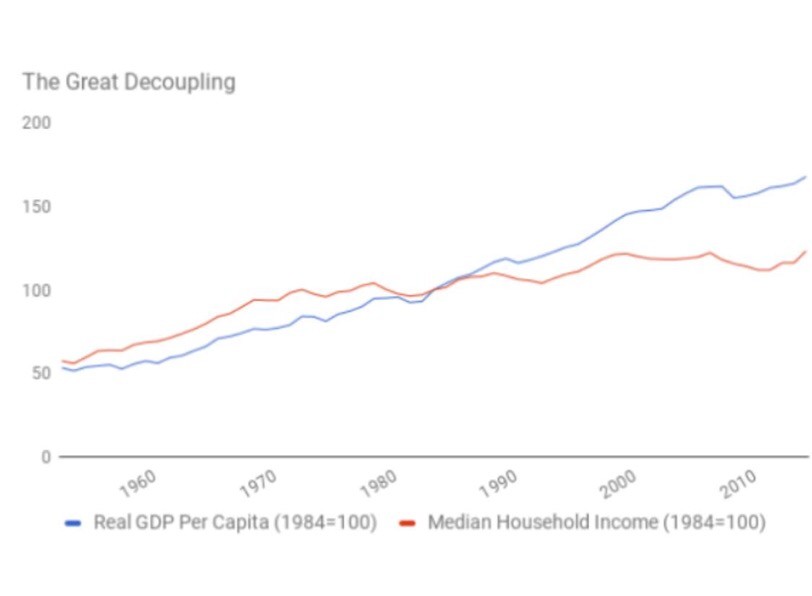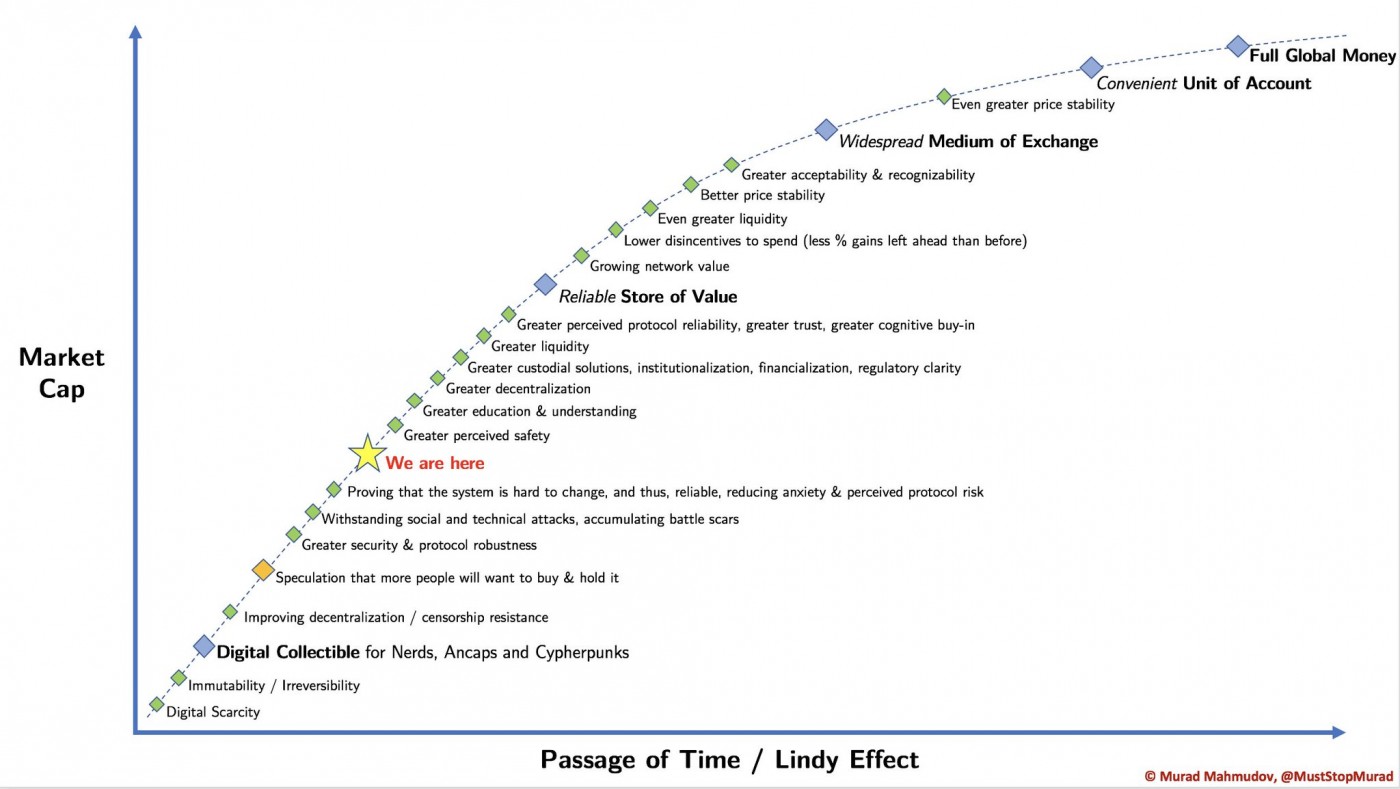Thus the two ETNs, GBTC (bitcoin) and ETCG (ethereum classic) are liable to continue to make excellent investments. While both trade above par value, this should remain a non-issue until a bitcoin ETF is approved in the U.S. Such approval will most likely not occur until sometime in 2020, so there is still ample time to make money from these ETNs. Grayscale is also launching the ETN ETHE which will track the price of ethereum.
Digital Self-Sovereignty
The transition from a trust-based economy to one of self-sovereignty will drive one of the largest wealth transfers in history. Barry Silbert who runs Grayscale and the two ETNs GBTC and ETCG says that, as I noted above, $68 trillion will be transferred to the millennials over the next 25 years. According to Silbert, “For the younger generation, money is digital.” Silbert’s position comes from the fact that the people in the ‘baby boomer’ generation are either retiring or getting close to retiring. According to a recent Accenture study, $30 trillion in wealth belonging to the generation born immediately after World War II is already being passed down to the younger generation. 90% of this generation has taken a pragmatic liking to bitcoin over gold. While both bitcoin and gold are scarce, fungible, malleable, and durable, bitcoin does each of these better. Some examples:
1) Bitcoin's ease of value transfer.
2) Bitcoin's ease of storage.
3) Diminishing volatility in bitcoin as bitcoin matures thus bitcoin's unit of account will solidify.
4) Bitcoin's supply level is fixed and transparent. This eliminates fears of the typical inflationary pressures associated with overproduction of gold that could diminish its value.
5) Bitcoin is on a disinflationary supply schedule while the global supply of gold has increased by 1-2% annually over the last century. The amount of gold could spike higher. Major advances in mining technology and space exploration could bring a surprisingly amount of gold supply onto the market.
6) While gold is used in industry, bitcoin's store-of-value trumps gold's use cases for numerous reasons cited in the section above.
7) Bitcoin transactions will eventually be instantaneous while storage in wallets or cold storage will become relatively hack-proof. Bitcoin is also counterfeit-proof unlike gold:
https://strategiccoin.com/why-bitcoin-is-superior-to-gold/
Silbert has also mentioned how more than 70% of its bitcoin buyers are now institutional. While much of this institutional money is from small crypto hedge funds, it is nevertheless institutional, akin to small and micro cap mutual and hedge funds that invest in stocks. Even though they are small, it does not disqualify them from being part of what is referred to as institutional capital. This is yet another illustration of how the big money is starting to get involved in the blockchain space. This is akin to the dot-com boom of the 1990s. Retail investors kicked it off but eventually institutional capital dominated the space by 1999. That said, mainstream retail has yet to invest in cryptocurrencies, thus another major tailwind is on its way, first by mainstream retail, then by institutional.
Government Control vs. Digital Self Sovereignty
While governments have always attempted to control the flow of money, blockchain undermines their attempts. Just because something has always happened in the past such as the U.S. government controlling anything to do with money does not mean it will continue to do so with the same level of success. The Chinese government has certainly been undermined by bitcoin despite its on again, off again attempts to squeeze the life out of bitcoin by way of outright bans against certain aspects of the technology. Indeed, many of its wealthy citizens are able to transfer millions outside of the country, overriding the $50,000 equivalent maximum. Russia’s Putin at first banned the technology until they realised its massive utility. Putin met with Vitalik Buterin, the founder of Ethereum, last year.
A major global shift is taking place from centralized forms of power to decentralized platforms which already enable the transfer of value outside of the hands of governments. DAOs (decentralized autonomous organisations) will further facilitate this evolution.
While some believe decentralized crypto exchanges (DEX’s) will cease to exist should the U.S. ban them because that’s the attitude the U.S. has always taken when it comes to the control of money, such exchanges are by their very nature not easily controlled. As an example, peer-to-peer illegal file sharing continues to grow since the days of Napster in the mid-1990s despite the tens of millions of taxpayer dollars used to attempt to quash such decentralized platforms.
While some say the U.S. will simply control the service providers who host such exchanges, VPNs and mesh networks are easy workarounds. In other words, there is always a way to circumvent policy as tech always trumps policy. Further, government tends to be the slow animal in the herd thus policy has been, is, and will continue to be trumped even more so today than ever before as blockchain technology takes hold. Regulation will help the blockchain/cryptospace mature enabling institutional capital to enter en masse.
Record Levels of Debt and The Great Decoupling
While QE rages on, interest rates at or near historical lows and going lower over the foreseeable future has pushed global debt to all-time highs. This has exacerbated the breakdown of the traditional correlation between US income and GDP growth as shown in the chart below. The crossing between these two measures occurred in the mid-1980s and was dubbed the “Great Decoupling”.

Since the CPI is well under what it should be due to the government removing components since the 1980s that rose in price the fastest, even the artificially inflated GDP numbers should be materially lower than reported. This has resulted in economic distress for the majority of Americans and Brits, two of the economically leading nations of the world. Income disparity between the top 1% and bottom 90% has never been greater. This has led to a search for off-grid solutions since major governments are not helping but instead, second order effects from QE are enriching the top 1% who tend to hold a greater share of hard assets, real estate, stocks, and bonds.
One off grid solution has had the fastest growth over the last decade. Forbes did an article a few years ago on how the D market (dark market) is the fastest growing market in the world. Note, goods and services exchanged in the D market are not typically of an illegal nature as the D market represents faster and more efficient ways of transacting typically at lower cost. Blockchain tech will accelerate this trend. The total value of the D market at the time stood at $11 trillion vs the U.S. GDP at $16 trillion. Forbes guessed that the size of the D market would surpass the U.S. market within a decade.
While bitcoin is the method of choice to transact value in the D market, blockchain by its very nature is transparent thus some governments have taken an interest in using blockchain to reduce or eliminate money laundering. Bitcoin having the highest hash rate by a massive margin makes it the most private and secure network which government agencies could utilize to track capital flows. So while bitcoin may have started out as a way to transact value for nefarious purposes, it will more likely be used to stop criminal activity as it matures. Indeed, using bitcoin for illicit activities will become far more difficult than using cash. That said, coins such as Monero, Zcash, and Dash which hide transactions may eventually be banned by more governments, in which case, these platforms will go underground much as illegal peer-to-peer file sharing continues to thrive two decades after Napster was taken down. For every p2p platform that gets shut down, ten new ones pop up. The billions of dollars in taxpayer money the U.S. government has spent since 1995 to stop this activity has come to naught.
Digitally Sovereign Decentralized Platforms
In any respective country, there is only one choice of currency. This is what drives banks’ and central banks’ margins. The great global monetary shift that takes place over the next several years will foster an ecosystem of many cryptocurrencies for applications existing on digitally sovereign decentralized platforms on the internet. This is transformational as such platforms will be outside the jurisdiction of governments and central banks. For those who insist the U.S. government controls all, their attempts to shut down p2p file sharing were ludicrously feeble.
At least the SEC regcognizes that bitcoin cannot be controlled short of blowing up the planet. Electricity shut off? There are always workarounds via mesh networks, satellite, and so forth. Anything government tries to do to stand in the way of decentralized progress will be futile. While control has always been achieved prior to decentralized tech, bitcoin, p2p file sharing, and other platforms represent the first type of tech that appears relatively invincible in its progress. Bitcoin itself has relentlessly grown in value from 0.001 in 2009 to over $9000 today despite various governments trying to derail it.
Bitcoin facilitates value transfer. The SEC has declared bitcoin decentralized thus not under regulatory scrutiny. That said, should its layer 2 technology Rootstock get underway in full measure, such companies with centralized authority that utilize Rootstock would have to register with the SEC as securities to remain compliant.
So despite attempts over the years to ban bitcoin by entire nations such as China and Russia, bitcoin remains the most secure and private platform due to its massive network effect which continues to grow exponentially. Bitcoin adoption (user base) doubles every 12 months. Bitcoin adoption is currently at roughly 1-2% of the world's population. Therefore, it took 10 years to get to 1-2% adoption (2009-2018). Over the next 10 years, bitcoin's user base could rise from the current 1-2% to 50% as the S-curve wave adoption approaches based on its adoption rate doubling every 12 months. Advantage: S-curve.
Another S-curve tsunami that is coming is the tokenization of most assets. The former CEO of the NASDAQ stock exchange recently said all stocks will be tokenised in 5 years. The CEO of CoinMetro thinks this will happen even sooner. The renowned angel investor Naval Ravikant would agree. He said 2 years ago that 90% of jobs on Wall Street will be gone in 7 years. I have said “Transform or die.”

 Since the CPI is well under what it should be due to the government removing components since the 1980s that rose in price the fastest, even the artificially inflated GDP numbers should be materially lower than reported. This has resulted in economic distress for the majority of Americans and Brits, two of the economically leading nations of the world. Income disparity between the top 1% and bottom 90% has never been greater. This has led to a search for off-grid solutions since major governments are not helping but instead, second order effects from QE are enriching the top 1% who tend to hold a greater share of hard assets, real estate, stocks, and bonds.
Since the CPI is well under what it should be due to the government removing components since the 1980s that rose in price the fastest, even the artificially inflated GDP numbers should be materially lower than reported. This has resulted in economic distress for the majority of Americans and Brits, two of the economically leading nations of the world. Income disparity between the top 1% and bottom 90% has never been greater. This has led to a search for off-grid solutions since major governments are not helping but instead, second order effects from QE are enriching the top 1% who tend to hold a greater share of hard assets, real estate, stocks, and bonds. 